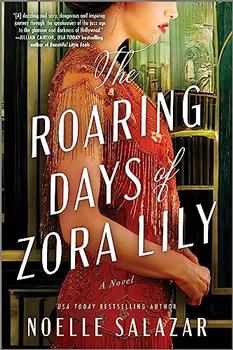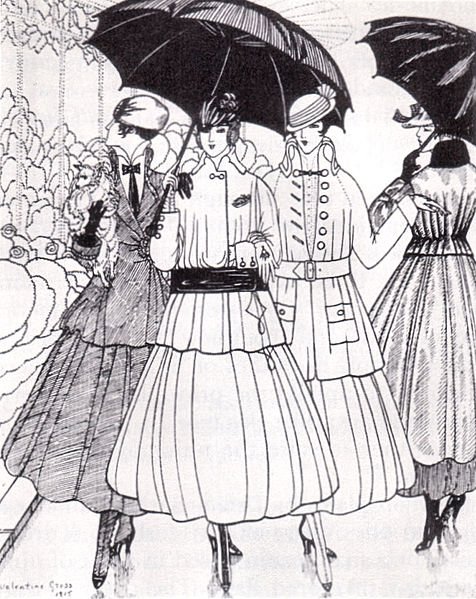Summary | Excerpt | Reading Guide | Reviews | Beyond the Book | Read-Alikes | Genres & Themes | Author Bio

A Novel
by Noelle SalazarThis article relates to The Roaring Days of Zora Lily
 Noelle Salazar's The Roaring Days of Zora Lily follows a fictional aspiring fashion designer living in Seattle in the 1920s. But who were the real fashion designers of the day? In Salazar's novel, Zora wants to have a career like Coco Chanel and Jeanne Lanvin. While most American readers have likely heard of the Chanel brand and its eponymous founder, fewer may be aware of her contemporary Lanvin. Nevertheless, Lanvin's fashion house is considered one of the most successful and innovative of her era, and she remains internationally known as a designer and perfumer, perhaps most notably for her iconic fragrance Arpège.
Noelle Salazar's The Roaring Days of Zora Lily follows a fictional aspiring fashion designer living in Seattle in the 1920s. But who were the real fashion designers of the day? In Salazar's novel, Zora wants to have a career like Coco Chanel and Jeanne Lanvin. While most American readers have likely heard of the Chanel brand and its eponymous founder, fewer may be aware of her contemporary Lanvin. Nevertheless, Lanvin's fashion house is considered one of the most successful and innovative of her era, and she remains internationally known as a designer and perfumer, perhaps most notably for her iconic fragrance Arpège.
Like Salazar's Zora, Lanvin came from modest beginnings and worked hard to achieve her dreams. Born to a large family in Paris in 1967, she started her first job at the age of 13, delivering for a hat shop and eventually completing a milliner's apprenticeship there. She also worked as a dressmaker's assistant in her teen years. Lanvin opened a small design studio at 18 and her own hat shop at 22. Four years later, she obtained a lease on a property on Rue du Faubourg Saint-Honoré, where she established the Lanvin fashion house.
 In 1895, Lanvin married Italian nobleman Henri Emilio Georges Di Pietro, and the couple's daughter, Marguerite, was born in 1897. Marguerite — later Countess Marie-Blanche de Polignac — became a lifelong creative inspiration to her mother, who began making more clothing for women and girls, and branched out into children's fashion as well as mother-daughter matching outfits. Her business continued to expand in the coming decades, with further milestones including the opening of a men's boutique (1926) and the release of the perfume Arpège (1927), which was created as a birthday present for Marie-Blanche. Artist Paul Iribe designed the image for the fragrance's packaging, a now-famous drawing of a mother and daughter that became the brand's logo.
In 1895, Lanvin married Italian nobleman Henri Emilio Georges Di Pietro, and the couple's daughter, Marguerite, was born in 1897. Marguerite — later Countess Marie-Blanche de Polignac — became a lifelong creative inspiration to her mother, who began making more clothing for women and girls, and branched out into children's fashion as well as mother-daughter matching outfits. Her business continued to expand in the coming decades, with further milestones including the opening of a men's boutique (1926) and the release of the perfume Arpège (1927), which was created as a birthday present for Marie-Blanche. Artist Paul Iribe designed the image for the fragrance's packaging, a now-famous drawing of a mother and daughter that became the brand's logo.
Lanvin, a collector of works by Renoir and Degas, among others, also took inspiration from the art world. Her clothes were known for their bold colors, along with their balancing of tradition with modernity and their decorative flourishes. Some of her most noteworthy designs are the "robe de style," a more elegant, lesser-known alternative to the "flapper" dress of the 1920s; a version of the high-waisted and short-sleeved classical Greek-style Empire dress; and her take on the Breton suit, featuring a gathered skirt and a short jacket with buttons.
After Lanvin's death at the age of 79 in 1946, her daughter took over the Lanvin company until 1958. The house has continued under a succession of other designers, including Jules-François Crahay, Maryll Lanvin and Cristina Ortiz. Today, Lanvin clothing and accessories can still be found at the brand's historical shop in Paris, as well as a New York location on Madison Avenue and many other stores around the world.
Portrait of Jeanne Lanvin (1925) by Clementine-Hélène Dufau, via Wikimedia Commons
Fashion plate from La Gazette du Bon Ton (1915), showing (left to right) tailored suits by Paquin, Lanvin and Doeuillet and a coat by Paquin, via Wikimedia Commons
Filed under People, Eras & Events
![]() This article relates to The Roaring Days of Zora Lily.
It first ran in the November 1, 2023
issue of BookBrowse Recommends.
This article relates to The Roaring Days of Zora Lily.
It first ran in the November 1, 2023
issue of BookBrowse Recommends.
Your guide toexceptional books
BookBrowse seeks out and recommends the best in contemporary fiction and nonfiction—books that not only engage and entertain but also deepen our understanding of ourselves and the world around us.